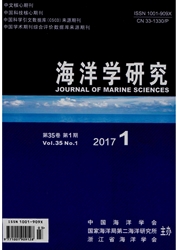

 中文摘要:
中文摘要:
运用美国麻省理工大学MITgcm模式、模式嵌套技术和高分辨率网格(水平方向为1°/48×1°/48,垂向为22层),模拟了宫古海峡通道中的海流流动状况。流场不同分辨率的模拟结果表明,海底地形对宫古海峡通道中的海流流动影响显著;宫古海峡通道中的海流流动结构具有如下特征:垂向流动可分为3层,每层均存在流速核心;400m以浅的上层海流从太平洋流入到东海,平均流速约为10cm/s,流速核心位于160m附近;400~1000m的中层海流从东海流出到太平洋,平均流速约为2cm/s,流速核心位于650m附近;1000m以下的深层海流从太平洋流入到东海,平均流速约为1cm/s,流速核心位于1200m附近。宫古海峡通道中的海流流动具有较强的季节变化特征,秋末冬初流动较强,夏季流动较弱。
 英文摘要:
英文摘要:
The 3-D circulation in Miyako Strait is simulated with a high resolution MITgcm. The results show that the bathymetry has significant influence on the circulation in the Miyako Strait. The circulation in the Miyako Strait is shown to have three regines in the vertical direction, each of them has maximum current core, which coincide with the vertical structure of the hydrography and chemistry. In the top 400 m layer, the current flows from the East China Sea to Pacific with an average speed of about 10 cm/s. Its max velocity core locates in 160 m. In the mid-layer from 400 to 1 000 m, the current is in the opposite direction to the upper layer with an average speed of about 2 cm/s. In the lower layer deeper than 1 000 m, the current flows in the same direction as that of the upper layer with a weak speed of about 1 cm/s. Its max velocity core locates in 1 200 m. The current in Miyako Strait has significant seasonal variability, stronger in later autumn and early winter while weaker in summer.
 同期刊论文项目
同期刊论文项目
 同项目期刊论文
同项目期刊论文
 期刊信息
期刊信息
